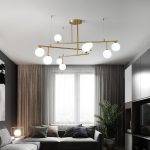
Introduction
The living room is an essential part of the home, where families gather to relax, entertain guests, and spend quality time together. Achieving the perfect ambiance for this space depends significantly on the lighting design. The lighting in your living room can affect the mood, comfort, and overall aesthetics of the room. In this article, we will explore some of the best living room lighting ideas to create a warm and inviting atmosphere that you can be proud of.
Types of Lighting
There are three main types of lighting that you should consider when designing your living room: ambient, task, and accent lighting.
Ambient Lighting
Ambient lighting is the primary source of light in a room, and its purpose is to provide overall illumination. This type of lighting should be evenly distributed throughout the living room to create a comfortable and relaxing atmosphere. Some popular examples of ambient lighting include:
- Overhead light fixtures
- Recessed lighting
- Chandeliers
- Lamps
Task Lighting
Task lighting is used for specific activities such as reading, writing, or any other focused work. This type of lighting is more localized and is commonly used in areas where additional illumination is needed. Common examples of task lighting include:
- Table lamps
- Desk lamps
- Floor lamps
Accent Lighting
Accent lighting is used to highlight specific objects, such as artwork, architectural features, or decorative items in the living room. This type of lighting should be used sparingly to avoid over-illumination. Popular examples of accent lighting include:
- Track lighting
- Wall sconces
- Picture lights
Tips for Living Room Lighting Design
Now that we have explored the different types of lighting, it’s time to discuss some tips for designing your living room lighting.
Layer Lighting
The key to a well-designed lighting scheme is layering different types of lighting to create depth and dimension. A combination of ambient, task, and accent lighting can create a warm and inviting atmosphere. In addition to layering, you can also experiment with dimmer switches to adjust the brightness of your lighting to match the mood of the room.
Consider Natural Lighting
Natural light is an excellent source of illumination and can make your living room feel more spacious and inviting. Consider using window treatments that allow natural light to enter the room while also providing privacy. You can also position furniture to maximize the amount of natural light that enters the room.
Choose the Right Bulbs
The type of bulb you use can significantly impact the look and feel of your living room. Incandescent bulbs provide a warm glow, while LED bulbs are energy-efficient and long-lasting. You can also experiment with different color temperatures to create different moods in the room.
Highlight Architectural Details
Architectural details, such as moldings, columns, or a fireplace, can be effectively highlighted with accent lighting. By directing light towards these features, you can create visual interest and add depth to the room.







